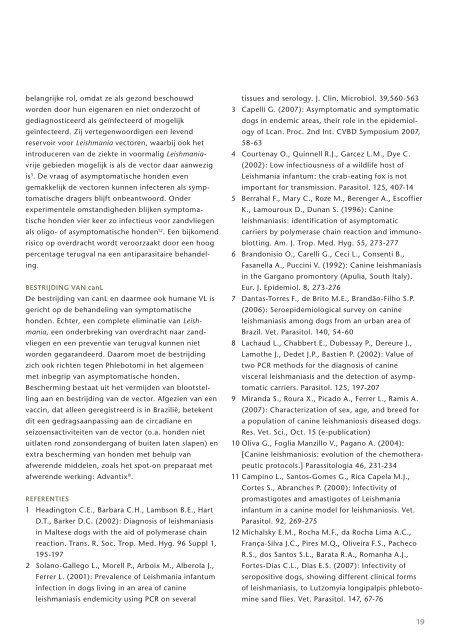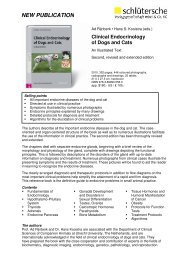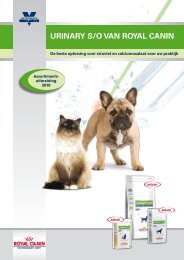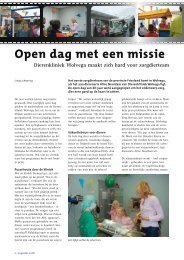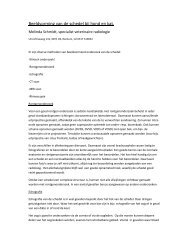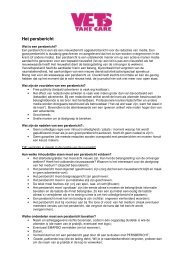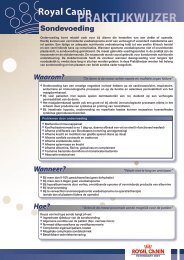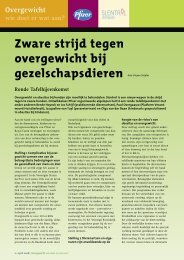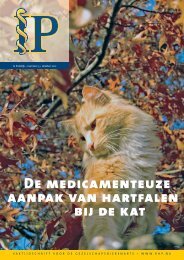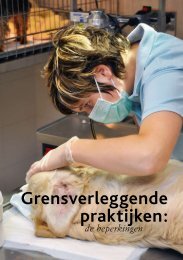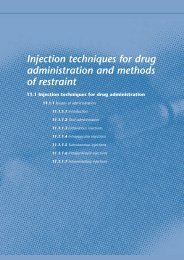Voedingsovergevoeligheid bij de kat - RHP - Roman House ...
Voedingsovergevoeligheid bij de kat - RHP - Roman House ...
Voedingsovergevoeligheid bij de kat - RHP - Roman House ...
Create successful ePaper yourself
Turn your PDF publications into a flip-book with our unique Google optimized e-Paper software.
elangrijke rol, omdat ze als gezond beschouwd<br />
wor<strong>de</strong>n door hun eigenaren en niet on<strong>de</strong>rzocht of<br />
gediagnosticeerd als geïnfecteerd of mogelijk<br />
geïnfecteerd. Zij vertegenwoordigen een levend<br />
reservoir voor Leishmania vectoren, waar<strong>bij</strong> ook het<br />
introduceren van <strong>de</strong> ziekte in voormalig Leishmania-<br />
vrije gebie<strong>de</strong>n mogelijk is als <strong>de</strong> vector daar aanwezig<br />
is3 . De vraag of asymptomatische hon<strong>de</strong>n even<br />
gemakkelijk <strong>de</strong> vectoren kunnen infecteren als symptomatische<br />
dragers blijft onbeantwoord. On<strong>de</strong>r<br />
experimentele omstandighe<strong>de</strong>n blijken symptomatische<br />
hon<strong>de</strong>n vier keer zo infectieus voor zandvliegen<br />
als oligo- of asymptomatische hon<strong>de</strong>n12 . Een <strong>bij</strong>komend<br />
risico op overdracht wordt veroorzaakt door een hoog<br />
percentage terugval na een antiparasitaire behan<strong>de</strong>ling.<br />
Bestrijding van canL<br />
De bestrijding van canL en daarmee ook humane VL is<br />
gericht op <strong>de</strong> behan<strong>de</strong>ling van symptomatische<br />
hon<strong>de</strong>n. Echter, een complete eliminatie van Leishmania,<br />
een on<strong>de</strong>rbreking van overdracht naar zandvliegen<br />
en een preventie van terugval kunnen niet<br />
wor<strong>de</strong>n gegaran<strong>de</strong>erd. Daarom moet <strong>de</strong> bestrijding<br />
zich ook richten tegen Phlebotomi in het algemeen<br />
met inbegrip van asymptomatische hon<strong>de</strong>n.<br />
Bescherming bestaat uit het vermij<strong>de</strong>n van blootstelling<br />
aan en bestrijding van <strong>de</strong> vector. Afgezien van een<br />
vaccin, dat alleen geregistreerd is in Brazilië, betekent<br />
dit een gedragsaanpassing aan <strong>de</strong> circadiane en<br />
seizoensactiviteiten van <strong>de</strong> vector (o.a. hon<strong>de</strong>n niet<br />
uitlaten rond zonson<strong>de</strong>rgang of buiten laten slapen) en<br />
extra bescherming van hon<strong>de</strong>n met behulp van<br />
afweren<strong>de</strong> mid<strong>de</strong>len, zoals het spot-on preparaat met<br />
afweren<strong>de</strong> werking: Advantix ® .<br />
referenties<br />
1 Headington C.E., Barbara C.H., Lambson B.E., Hart<br />
D.T., Barker D.C. (2002): Diagnosis of leishmaniasis<br />
in Maltese dogs with the aid of polymerase chain<br />
reaction. Trans. R. Soc. Trop. Med. Hyg. 96 Suppl 1,<br />
195-197<br />
2 Solano-Gallego L., Morell P., Arboix M., Alberola J.,<br />
Ferrer L. (2001): Prevalence of Leishmania infantum<br />
infection in dogs living in an area of canine<br />
leishmaniasis en<strong>de</strong>micity using PCR on several<br />
tissues and serology. J. Clin. Microbiol. 39,560-563<br />
3 Capelli G. (2007): Asymptomatic and symptomatic<br />
dogs in en<strong>de</strong>mic areas, their role in the epi<strong>de</strong>miology<br />
of Lcan. Proc. 2nd Int. CVBD Symposium 2007,<br />
58-63<br />
4 Courtenay O., Quinnell R.J., Garcez L.M., Dye C.<br />
(2002): Low infectiousness of a wildlife host of<br />
Leishmania infantum: the crab-eating fox is not<br />
important for transmission. Parasitol. 125, 407-14<br />
5 Berrahal F., Mary C., Roze M., Berenger A., Escoffier<br />
K., Lamouroux D., Dunan S. (1996): Canine<br />
leishmaniasis: i<strong>de</strong>ntification of asymptomatic<br />
carriers by polymerase chain reaction and immunoblotting.<br />
Am. J. Trop. Med. Hyg. 55, 273-277<br />
6 Brandonisio O., Carelli G., Ceci L., Consenti B.,<br />
Fasanella A., Puccini V. (1992): Canine leishmaniasis<br />
in the Gargano promontory (Apulia, South Italy).<br />
Eur. J. Epi<strong>de</strong>miol. 8, 273-276<br />
7 Dantas-Torres F., <strong>de</strong> Brito M.E., Brandão-Filho S.P.<br />
(2006): Seroepi<strong>de</strong>miological survey on canine<br />
leishmaniasis among dogs from an urban area of<br />
Brazil. Vet. Parasitol. 140, 54-60<br />
8 Lachaud L., Chabbert E., Dubessay P., Dereure J.,<br />
Lamothe J., De<strong>de</strong>t J.P., Bastien P. (2002): Value of<br />
two PCR methods for the diagnosis of canine<br />
visceral leishmaniasis and the <strong>de</strong>tection of asymptomatic<br />
carriers. Parasitol. 125, 197-207<br />
9 Miranda S., Roura X., Picado A., Ferrer L., Ramis A.<br />
(2007): Characterization of sex, age, and breed for<br />
a population of canine leishmaniosis diseased dogs.<br />
Res. Vet. Sci., Oct. 15 (e-publication)<br />
10 Oliva G., Foglia Manzillo V., Pagano A. (2004):<br />
[Canine leishmaniosis: evolution of the chemotherapeutic<br />
protocols.] Parassitologia 46, 231-234<br />
11 Campino L., Santos-Gomes G., Rica Capela M.J.,<br />
Cortes S., Abranches P. (2000): Infectivity of<br />
promastigotes and amastigotes of Leishmania<br />
infantum in a canine mo<strong>de</strong>l for leishmaniosis. Vet.<br />
Parasitol. 92, 269-275<br />
12 Michalsky E.M., Rocha M.F., da Rocha Lima A.C.,<br />
França-Silva J.C., Pires M.Q., Oliveira F.S., Pacheco<br />
R.S., dos Santos S.L., Barata R.A., <strong>Roman</strong>ha A.J.,<br />
Fortes-Dias C.L., Dias E.S. (2007): Infectivity of<br />
seropositive dogs, showing different clinical forms<br />
of leishmaniasis, to Lutzomyia longipalpis phlebotomine<br />
sand flies. Vet. Parasitol. 147, 67-76<br />
19


